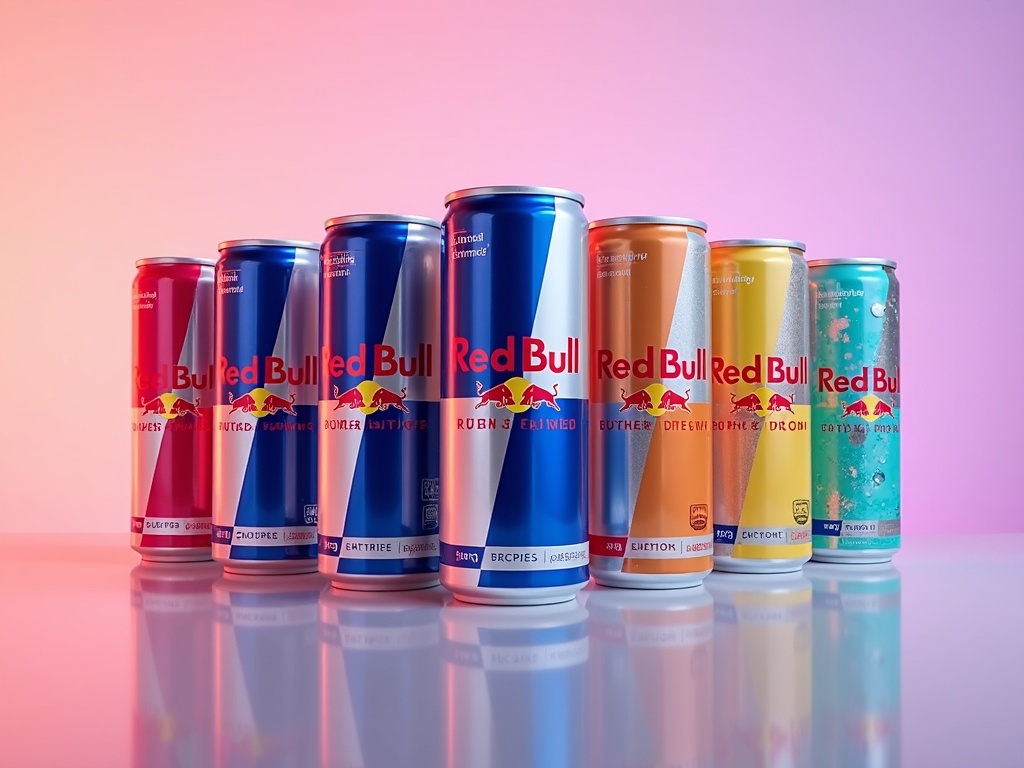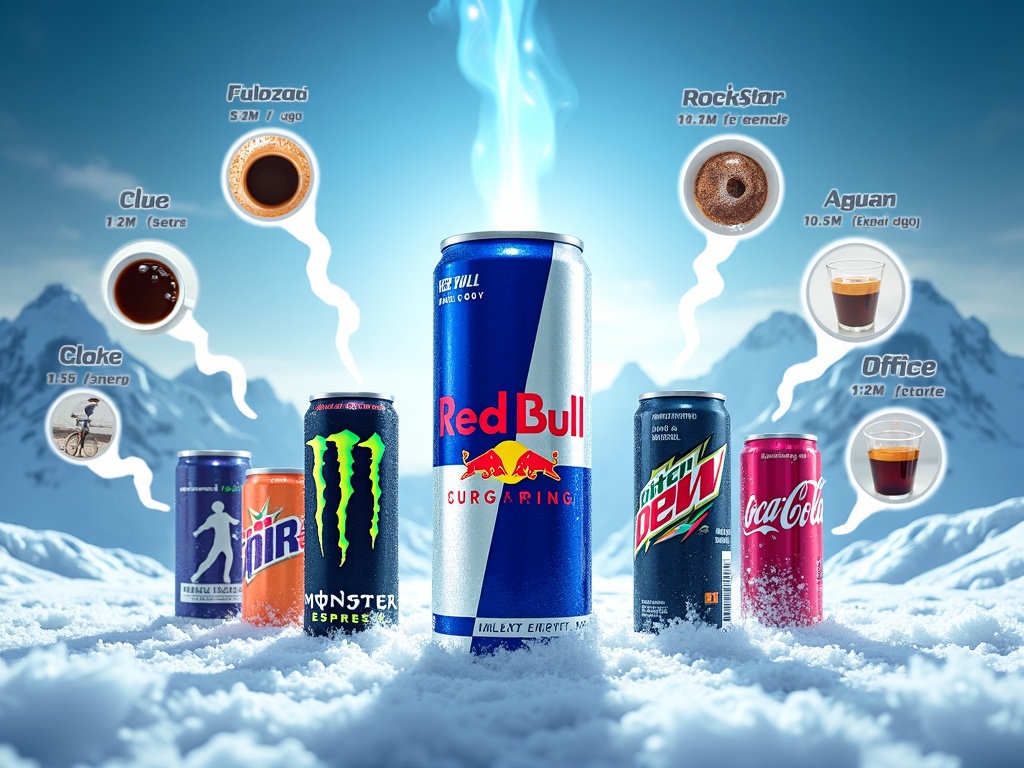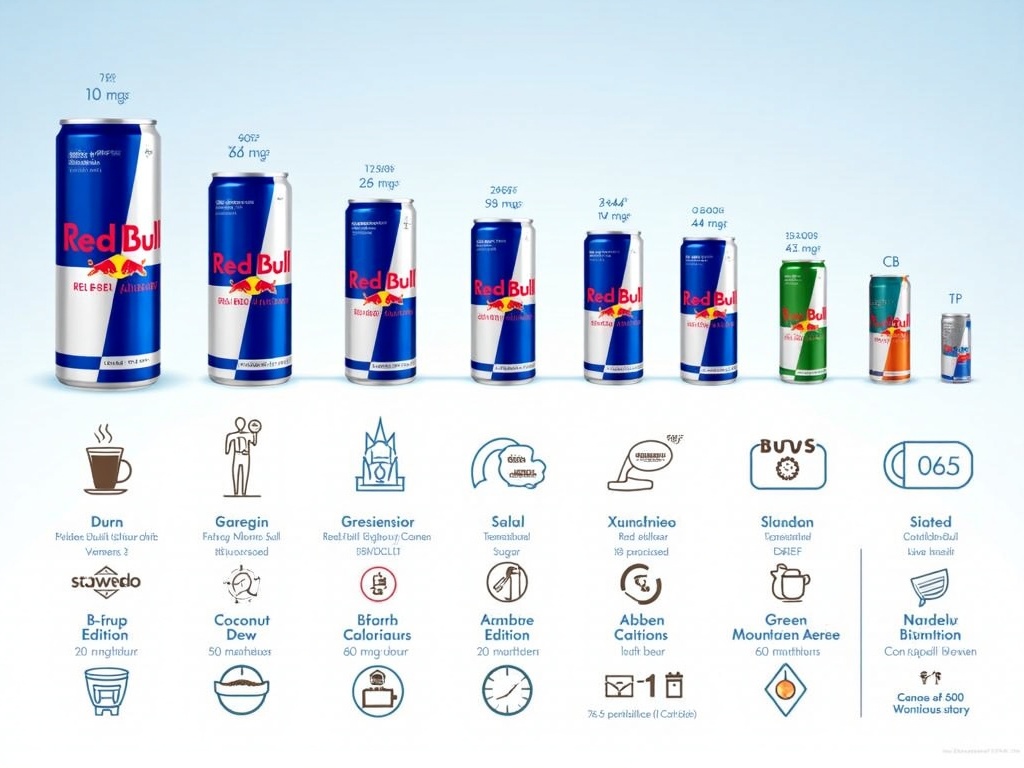No products in the cart.
Beverages News, Energy Drinks, Red Bull Energy Drink
How Much Caffeine In Red Bull Energy Drink
A standard 8.4 fl oz Red Bull energy drink contains 80 milligrams of caffeine, which positions it as a moderate-strength energy option compared to coffee and other energy drinks. This caffeine content remains consistent across all Red Bull flavors and formulations, making it easier for consumers to track their daily caffeine intake regardless of their taste preferences.
Table of Contents
Key Takeaways
- Red Bull contains 80 mg of caffeine per 8.4 fl oz can, which is less than a typical cup of coffee (95 mg) but more than regular sodas.
- All Red Bull products maintain the same caffeine concentration of 9.5 mg per fluid ounce, regardless of flavor, sugar content, or can size.
- Larger Red Bull cans contain proportionally more caffeine:
- 12 fl oz – 114 mg
- 16 fl oz – 151 mg
- 20 fl oz – 188 mg
- The FDA recommends limiting daily caffeine intake to 400 mg for healthy adults, which equals approximately five standard Red Bull cans.
- Red Bull’s moderate caffeine level makes it a middle-ground option between high-caffeine energy drinks like Bang Energy (300 mg) and regular soft drinks.
Red Bull’s Caffeine Content: What’s Actually in That Little Can?
I’ll break down exactly what you’re getting when you crack open that iconic blue and silver can. A standard 8.4 fl oz (250 ml) can of Red Bull Energy Drink packs 80 milligrams of caffeine – a precise amount that’s been carefully formulated since the brand’s inception.
How Red Bull’s Caffeine Compares
Red Bull’s 80 mg caffeine content actually falls below what you’d find in your morning coffee. A typical 8 oz cup of home-brewed coffee delivers approximately 95 mg of caffeine, making it stronger than Red Bull by about 15 mg. This positioning makes Red Bull a moderate caffeine choice rather than an extreme one.
The caffeine in Red Bull energy drink ingredients is synthetically produced, ensuring consistency across every can. This synthetic approach provides predictable effects without the variability you might experience with naturally sourced caffeine from different coffee beans or tea leaves.
What Else Powers the Energy Formula
Caffeine serves as the primary stimulant, but it doesn’t work alone in Red Bull’s formula. The brand combines caffeine with several other key components that contribute to its energizing effects:
- Taurine – an amino acid that supports various bodily functions
- B-group vitamins – essential for energy metabolism
- Sugars – providing quick energy (or artificial sweeteners in sugar-free versions)
- Alpine water – the base for all other ingredients
Understanding why Red Bull gives you wings involves recognizing how these ingredients work together. The caffeine provides the alertness boost, while the other components support sustained energy release and metabolic function.
Red Bull’s moderate caffeine level makes it accessible for different tolerance levels while still delivering noticeable effects. Whether you’re comparing it to other energy drinks or considering it for specific activities like driving, the 80 mg caffeine content strikes a balance between effectiveness and manageability. This measured approach has helped establish Red Bull as a reliable choice for those seeking controlled energy enhancement without excessive stimulation.

Caffeine Content in Different Red Bull Sizes: The Complete Breakdown
I’ll break down the exact caffeine content across all Red Bull can sizes so you can make informed choices about your energy drink consumption. Red Bull maintains a consistent caffeine concentration of approximately 9.5 mg per fluid ounce across all can sizes, which means larger cans deliver proportionally more caffeine.
The standard 8.4 fl oz (250 ml) Red Bull can contains 80 mg of caffeine. This represents the original size and serves as the baseline for caffeine calculations. Moving up to the 12 fl oz (355 ml) can, you’ll consume 114 mg of caffeine. The 16 fl oz (473 ml) can delivers 151 mg of caffeine, while the largest 20 fl oz (591 ml) can provides 188 mg of caffeine.
Size-by-Size Caffeine Breakdown
Here’s exactly how much caffeine you’ll get from each Red Bull size:
- 8.4 fl oz (250 ml): 80 mg caffeine
- 12 fl oz (355 ml): 114 mg caffeine
- 16 fl oz (473 ml): 151 mg caffeine
- 20 fl oz (591 ml): 188 mg caffeine
I recommend starting with the smallest size if you’re new to energy drinks or sensitive to caffeine. The 8.4 fl oz can provides a moderate energy boost without overwhelming your system. For regular energy drink users, the 12 fl oz option offers a good balance between effectiveness and caffeine intake. The larger 16 fl oz and 20 fl oz cans deliver significant caffeine doses that work well for intense activities or when you need sustained energy.
Understanding these measurements helps you manage your daily caffeine intake more effectively. The FDA recommends limiting caffeine consumption to 400 mg per day for healthy adults. This means you could safely consume up to two 20 fl oz cans daily, though I’d suggest spacing them out throughout the day rather than drinking them consecutively.
Red Bull’s consistent concentration formula makes calculating your caffeine intake straightforward. Simply multiply the fluid ounces by 9.5 to determine the approximate caffeine content. This consistency ensures you get predictable results regardless of which size you choose.
The Red Bull energy drink ingredients work synergistically with caffeine to enhance its effects. Taurine, B-vitamins, and sugar complement the caffeine content to create the distinctive energy boost that makes Red Bull give you wings.
Consider your tolerance level and intended use when selecting your Red Bull size. Athletes and drivers often prefer larger sizes for extended energy support, while office workers might find the standard 8.4 fl oz can sufficient for afternoon productivity boosts. The beauty of Red Bull’s sizing options lies in their flexibility to match different energy needs and caffeine tolerances.
Keep track of your total daily caffeine intake from all sources, including coffee, tea, and other caffeinated beverages. Red Bull’s clear labeling makes this easier, but combining it with other caffeinated products can quickly push you over recommended limits. I suggest choosing one primary caffeine source per day and adjusting portions accordingly.
The caffeine content remains stable regardless of flavor variations or seasonal offerings. Whether you choose original Red Bull or specialty flavors, the caffeine concentration stays consistent at 9.5 mg per fluid ounce across all product lines.
All Flavors, Same Kick: Caffeine Across Red Bull Product Lines
I can confirm that caffeine content remains remarkably consistent across all Red Bull products of the same size. Whether you choose the original formula, a sugar-free version, or one of the colorful flavored editions, you’ll get exactly 80 mg of caffeine in every 8.4 fl oz can.
This standardization applies to Red Bull Sugarfree, Red Bull Zero, and all flavored options known as Red Bull Editions. The brand maintains this caffeine consistency as a core principle, ensuring that consumers receive the same energy boost regardless of their flavor preference or dietary requirements.
Understanding the Product Variations
While caffeine levels don’t vary between products, the main differences lie in taste profiles and sweetening methods. Here’s what distinguishes each category:
- Red Bull Original contains sugar and delivers the classic taste
- Red Bull Sugarfree uses artificial sweeteners instead of sugar
- Red Bull Zero combines zero calories with zero sugar using alternative sweeteners
- Red Bull Editions offer unique flavors while maintaining the same caffeine formula
The flavored Editions include:
- Red Edition (Watermelon)
- Blue Edition (Blueberry)
- Yellow Edition (Tropical)
- Amber Edition (Strawberry Apricot)
- Green Edition (Dragon Fruit)
- Coconut Edition (Coconut Berry)
Each edition provides a distinct taste experience while delivering the same 80 mg caffeine content that defines Red Bull’s energy formula.
I find this consistency particularly valuable for consumers who want to track their caffeine intake precisely. You don’t need to guess or calculate different amounts based on flavor choice – every standard-sized can delivers the same stimulant effect. This approach also simplifies the decision-making process, allowing you to choose based purely on taste preference rather than worrying about varying energy levels.
The brand’s commitment to maintaining identical caffeine content across all variations demonstrates their focus on delivering predictable results. Whether you prefer the tropical taste of the Yellow Edition or stick with the original formula, you can expect the same energy boost that has made Red Bull synonymous with reliable energy.

Energy Drink Showdown: How Red Bull Compares to Competitors
I often get asked how Red Bull stacks up against other caffeinated beverages, and the answer reveals some surprising insights about this iconic energy drink’s positioning. A standard 8.4 fl oz Red Bull contains 80 mg of caffeine, which places it in a moderate range compared to various beverages across different categories.
Coffee and Espresso Comparisons
Red Bull actually contains less caffeine than your typical home-brewed coffee. An 8 oz cup of home-brewed coffee delivers about 95 mg of caffeine, while a single 1 oz shot of espresso contains around 64 mg. This means that ounce-for-ounce, coffee packs more caffeine at approximately 12 mg per ounce compared to Red Bull’s 9.5 mg per ounce. Coffee drinkers looking to switch to Red Bull energy drink might notice a slightly different energy experience due to this caffeine difference.
Energy Drink Category Rankings
Within the energy drink category itself, Red Bull sits on the more conservative side of the caffeine spectrum. The major competitors significantly outpace Red Bull’s caffeine content:
- Monster (16 fl oz) contains 160 mg of caffeine – exactly double Red Bull’s amount
- Rockstar (16 fl oz) also delivers 160 mg of caffeine
- Bang Energy (16 fl oz) pushes the envelope with 300 mg of caffeine – nearly four times Red Bull’s content
These larger cans also provide more liquid volume, but even when adjusted for serving size, most competitors still deliver higher caffeine concentrations. This positioning suggests Red Bull focuses on providing balanced energy rather than maximum caffeine intensity.
Regular sodas contain significantly less caffeine than Red Bull. Coca-Cola (12 fl oz) provides just 34 mg, Diet Coke steps up to 46 mg, and Mountain Dew reaches 54 mg of caffeine. This makes Red Bull’s 80 mg notably higher than traditional soft drinks, positioning it clearly as an energy-focused beverage rather than a casual refreshment.
I find Red Bull’s moderate caffeine approach interesting because it allows the brand to differentiate itself through other ingredients and marketing rather than competing purely on caffeine strength. The company has built its reputation around the complete Red Bull experience, which includes taurine, B-vitamins, and alpine water alongside caffeine.
For consumers choosing between energy drinks, Red Bull offers a middle-ground option. It provides more caffeine than sodas and matches espresso shots while remaining below coffee levels. This makes it suitable for people who want an energy boost without the intensity that comes with high-caffeine alternatives like Bang Energy.
The energy drink comparison reveals that Red Bull’s success doesn’t stem from having the highest caffeine content. Instead, the brand has carved out a niche by offering consistent, moderate energy enhancement that appeals to a broad consumer base. For drivers and professionals who need sustained alertness without jitters, this moderate caffeine level often proves ideal.
Understanding these caffeine differences helps consumers make informed choices based on their specific energy needs and caffeine tolerance levels. Red Bull’s positioning demonstrates that effective energy drinks don’t always need maximum caffeine to deliver results.

How Much Is Too Much? FDA Guidelines and Red Bull Consumption
The FDA establishes clear boundaries for safe caffeine consumption, setting the daily limit at 400 milligrams for healthy adults. This translates to approximately five 8.4 fl oz cans of Red Bull throughout a single day. I find this guideline particularly useful because it provides a concrete reference point for responsible energy drink consumption.
However, timing matters significantly more than just the total daily amount. Consuming multiple cans within a short timeframe can trigger uncomfortable side effects, even if you stay under the 400-milligram threshold. Jitteriness, anxiety, and increased heart rate commonly occur when caffeine hits your system too rapidly. I recommend spacing out consumption throughout the day rather than drinking several cans consecutively.
Special Considerations for Different Groups
The FDA’s 400-milligram guideline doesn’t apply universally across all populations. Several groups should exercise extra caution or avoid high caffeine intake entirely:
- Children and adolescents have lower tolerance levels and should avoid energy drinks altogether
- Pregnant women should limit caffeine to 200 milligrams daily according to medical recommendations
- Breastfeeding mothers need to consider caffeine’s transfer through breast milk
- Individuals with heart conditions, anxiety disorders, or other health issues should consult healthcare providers
- People taking certain medications may experience dangerous interactions with caffeine
Caffeine sensitivity varies dramatically between individuals, making personal awareness crucial. Some people metabolize caffeine quickly and can handle higher amounts, while others experience effects from relatively small doses. I’ve observed that Red Bull’s caffeine content affects people differently based on their tolerance levels, body weight, and consumption habits.
Moderation becomes especially important if you’re sensitive to stimulants. Start with smaller amounts and monitor your body’s response before increasing consumption. Pay attention to sleep patterns, as caffeine can disrupt rest even when consumed earlier in the day. The half-life of caffeine ranges from 3 to 7 hours, meaning it stays active in your system longer than many people realize.
Consider your total daily caffeine intake from all sources, not just energy drinks. Coffee, tea, chocolate, and certain medications also contribute to your daily total. Understanding how Red Bull works can help you make informed decisions about combining it with other caffeinated products.
I recommend keeping a simple log of your caffeine consumption for a week to understand your current intake patterns. This practice reveals hidden sources and helps you stay within safe limits while maximizing the benefits you seek from energy drinks.
Sources:
Red Bull – How Much Caffeine in Red Bull
U.S. Food and Drug Administration (FDA) – Spilling the Beans: How Much Caffeine is Too Much?
Caffeine Informer – Caffeine Content: Red Bull
Healthline – Red Bull and Caffeine: What You Need to Know


